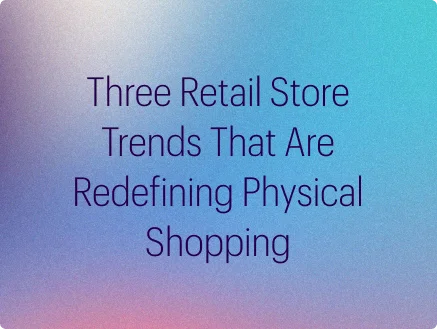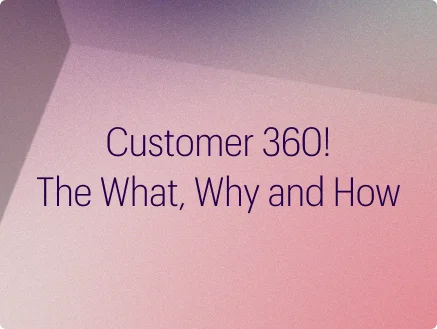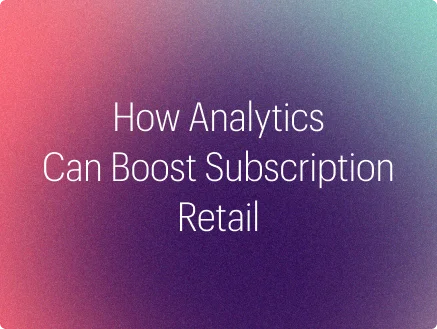In the ever-changing world of retail, running focused promotions that deliver has never been more critical than now. With increased volume play being a core part of their strategy, for retailers in the fashion & lifestyle retail space who typically handle high inventory turnover, Promotional Performance measurement becomes a cornerstone of success. If done right, sales promotions not only deliver a steep sales uptick but also help in new customer acquisition & achieve brand loyalty. However, effectively measuring promo impact goes beyond simple sales volume metrics.
In this article, we will explore how an advanced analytics approach coupled with the right business understanding can revolutionize how promotional impact is measured.
Promotion Effectiveness Measurement & the Fallacies of Traditional Estimation Methods
Simply put, promotion effectiveness measurement is the process by which retailers understand the effectiveness of their past promotions. This sets the tone not just for future promo planning but overall sales & inventory strategy, thereby having a direct impact on profitability.
Retailers typically lead future promotion planning with target sell–throughs, sales volume & sales dollars they need to achieve. Once sales are realized, based on how much additional business the promotional period has brought in vs targets/forecasts, the success of the promotion is gauged – simplistic metrics like overall sales volume lift and conversion rate are measured.
However, effective promotion measurement is more than just tracking sales spikes in Excel as these traditional methods lack granularity and often fail to capture the nuanced impact of promotions on customer behavior and profitability. Without a comprehensive view of business context to support an analytical approach, retailers risk misallocating resources and missing growth opportunities.
Catalysts for Change in Fashion Retail
The digital transformation of retail and evolving consumer preferences are catalysts for rethinking promotion measurement strategies. Modern consumers demand personalized experiences, and traditional one-size-fits-all promotions are becoming less effective. To stay competitive, retailers must adopt data-driven approaches that optimize promo strategies based on real-time insights.
Enterprise brands that serve customers at scale across channels must respond to these changes in a timely fashion to ensure brand longevity. Trends to capitalize on include:
AI-Driven Insights & Personalization[1]
- Predictive Analytics: AI can predict which promotions will yield the highest ROI. Whether it’s optimizing promo timing or attributing/isolating various factors that contribute to sales to analyze insights at a much granular level, insights from predictive analytics tools enable teams to increase efficiency and maximize ROI of Product Promotions.
- Personalized Promotions: AI algorithms can shorten the time to analyze customer behavior, preferences, and historical data to tailor promotions. By understanding individual shopping patterns, retailers can deliver targeted offers that resonate with the consumer, thereby increasing the probability of success of Marketing Promotions.
Omnichannel Integration
In this digital era, customers move fluidly between online and offline channels. Promotion effectiveness measurement must account for this omnichannel behavior to simplify the purchase process for the customer. Did an online promotion drive in-store foot traffic? Did an in-store event boost online sales? Omnichannel integration quality and customer satisfaction go together and can lead to improved promotion effectiveness[2].
- Attribution Modeling: Attribute sales across touchpoints to determine what’s most effective along the buyer journey. Several common models are out there to tailor to the brand’s business needs: last click – gives all credit to the touchpoint before conversion, first click – the opposite of last click, linear – useful for maintaining awareness throughout the buyer journey, time decay – great for short sales cycles (hint-hint, promotion!), and many more. These models provide a holistic view of promo impact [3].
Here at MathCo, some of the advanced analytics capabilities we have adopted in solving clients’ problems in Fashion Retail include:
- Granular Analysis: In-depth style-level (5-6 hierarchical levels below ‘’Gender/Category’’ level attribution) modeling & analysis to uncover hidden patterns and identify impactful promotions
- Real-Time Insights: Through MLOPs, data pipelines, and dashboards, offer real-time visibility into promotion performance, enabling agile merchandise planning decision-making
- Attribution Modeling: Attribute sales uplift to specific promotions, providing clarity on campaign effectiveness
- Predictive Analytics: Help clients by simulating promotion outcomes to proactively adapt strategies during decision-making to maximize ROI
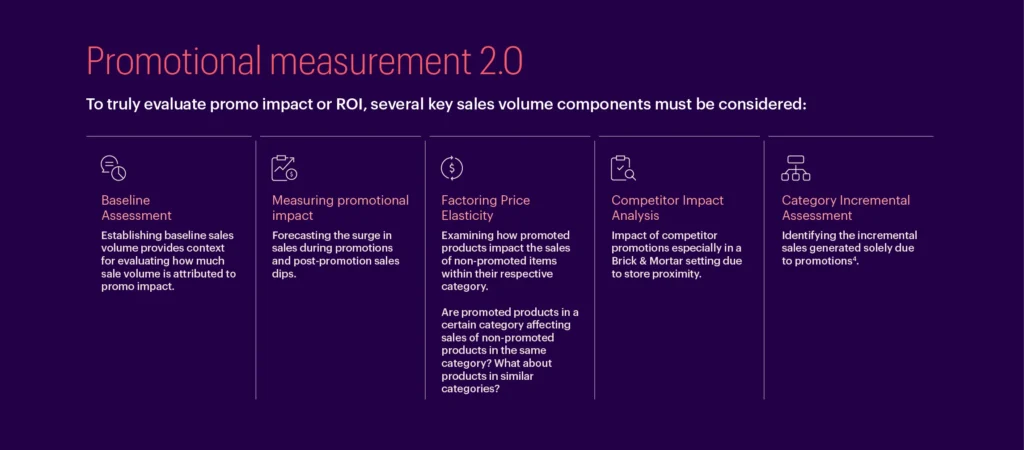
Our solutioning in an engagement with an activewear retailer in the sports & fitness category is a great example of this advanced approach toward analyzing promotion measurement. Their extensive promo-driven strategy and focus on margin maximization resulted in the need for an advanced analytics tool that isolates the impact of promotions on total sales among various contributing factors to analyze promotion insights in a deeper fashion.
After thorough contextualization of their business needs, we built an end-to-end promotion effectiveness measurement tool for their merchandise planning & pricing teams. By understanding changes in their historic sales patterns, the retailer gained insights into when and what promotions were the most and least impactful. This not only helped in maximizing inventory turnover & sales during high-impact periods but also provided them the ability to cut back on promotion spending during low-return periods, thereby creating a more robust promotional strategy while optimizing margins.
Integrating Change Management
The critical factor in embracing advanced analytics solutions in promotion measurement in complex, largely functional organizations is how effectively change management is embedded in the end-to-end processes. Integrating change management ensures that the efforts to optimize promotional strategies align with the overall business objectives, enabling better adoption, thereby providing a competitive edge. Without proper measurement of change management, organizations risk wasting resources and potentially derailing progress. Some common pitfalls while implementing analytical solutions include:
- User Experience – hazy definitions with a lack of understanding, and an unclear structure of information.
- User Interface – insights take too long to map, and solution design isn’t intuitive.
- Last Mile Adoption – learning curve is steep with too many features and a lack of integration to existing workflows.
By effectively measuring change management impact and adopting strategies during the build, launch & post-launch retailers can align promotional efforts with evolving consumer demands and business objectives.
Our engagement with a leading North American beverage company perfectly exemplifies how effective change management could lead to translated business value much more seamlessly. In this project, we built a tool that helped them optimize their manufacturing process & a critical step in accomplishing this is understanding their manufacturing risks and creating methods to mitigate them. Their existing process included spending hours building custom reports by business teams across disparate tools for site operators with limited technical training to understand & implement.
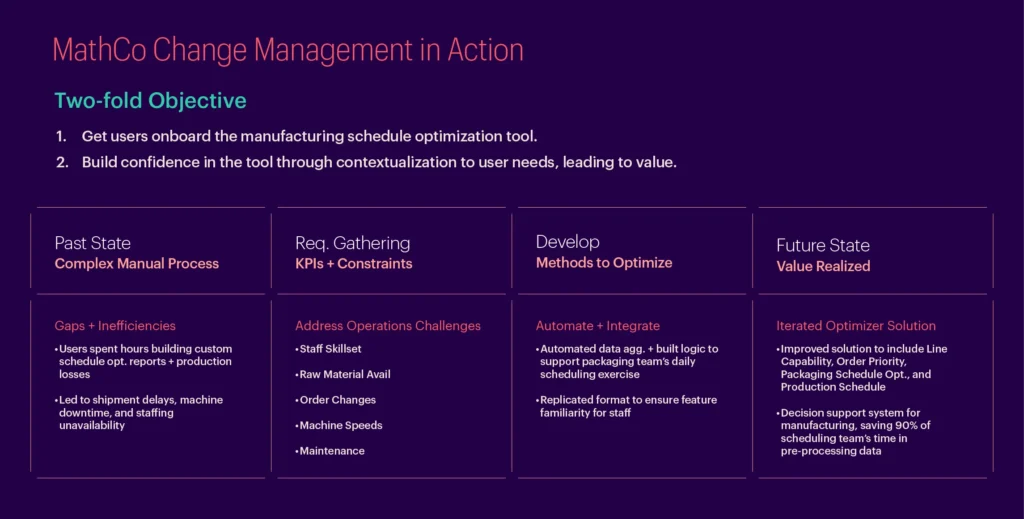
MathCo started the project by stepping into their daily routine, outlining their manufacturing & scheduling processes to understand their needs, KPIs that are must-haves & good-to-haves, and constraints, ensuring the practicability of a one-stop dashboarding tool to integrate into their risk mitigation strategy. We set objectives to get users on board the tool as early as possible and build user confidence in the tool by guiding them to realize the value of the manufacturing schedule optimization views we built. Once the core team was onboarded, we gained insights into how to pare down every aspect of the tool to make it agile & robust – through tool component usage, end users iterated on the tool’s scope, and we worked closely with them right from the start to contextualize the tool to their needs.
We reduced day-to-day inefficiencies and decreased time-to-insights from a few hours to a few minutes. This created instant value through digital transformation from scattered reports to a single site for manufacturing end users to rapidly find the reports they needed and account for heuristic-based schedule planning processes that were previously undocumented. The focus on value realization every step of the way and early in the process made for stellar change management and the success of the tool, which resulted in the expansion of tool implementation across 6 different manufacturing sites.
Through sustained collaboration, active listening, and an agile way of feature implementation, we were able to cultivate an ownership mindset with the end users, which ultimately resulted in the business value realization that we aimed for.
Conclusion
Despite the inflation rate hovering over[5] 4% consistently, consumer spending is on the rise, with clothing and footwear categories predicted to grow +20% in the next 5 years, after 9 consecutive increasing years in fashion-related spending[6].
Retrospective promotion measurement is not only a key pillar to effective future promotion planning, but it also has a very strong impact across the fashion retail value chain from Open to Buy (OTB) Planning, Assortment planning, Strategic Pricing, Marketing strategy, Category & Inventory Planning to Store Operations. To measure the success of promotions accurately, it’s important to contextualize, visualize & understand the actual volume, sales, and margin lifts attributed to each promotion.
Leading brands in the fashion retail space have already started adopting Advanced Analytics, Artificial Intelligence & Machine Learning solutions in retrospective promotion measurement & future promotion planning to create nimble, targeted promotional strategies that deliver. It’s high time companies with a more traditional outlook to promotion planning start adopting these in the changing economic environment we live in, as more retailers will vie for customers’ share of wallet in the coming years.
Bibliography
[1] “Predictive Analytics in Marketing.” Snowflake, www.snowflake.com/guides/predictive-analytics-marketing. Accessed 10 May 2024.
[2] Butkouskaya, Vera, et al. “The impact of Omnichannel Integrated Marketing Communications (IMC) on product and retail service satisfaction.” Journal of Economics, Finance and Administrative Science, vol. 28, no. 56, 17 May 2023, pp. 319–334,
https://doi.org/10.1108/jefas-09-2022-0237.
[3] Larkin, Kayle. “A Comprehensive Guide to Marketing Attribution Models.” Search Engine Journal, 3 Dec. 2022,
www.searchenginejournal.com/perfect-attribution-model/217893/.
[4] Kessler, Lovrenc. “How to Best Measure Promotional Effectiveness: Everything You Need to Know for Calculating Promotion Roi.” How to Best Measure Promotional Effectiveness & Calculate ROI, 6 Oct. 2019,
www.simon-kucher.com/en/insights/how-best-measure-promotional-effectiveness-everything-you-need-know-calculating-promotion.
[5] “Inflation rate by year’’, Investopedia https://www.investopedia.com/inflation-rate-by-year-7253832#:~:text=In%202023%2C%20the%20average%20rate,rate%20of%20inflation%20was%204.7%25, Accessed May 31st 2024
[6] “Total consumer spending on clothing and footwear worldwide from 2014 to 2029’’, Statista,
https://www.statista.com/forecasts/1161735/fashion-consumer-spending-forecast-in-the-world, Accessed May 31st 2024
